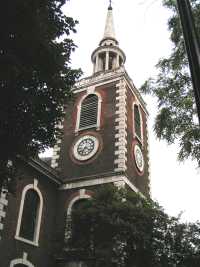St Mary's Church, Rotherhithe facts for kids
Quick facts for kids St Mary's Church, Rotherhithe |
|
|---|---|

Tower of St Mary's Church, Rotherhithe
|
|
| 51°30′05″N 0°03′14″W / 51.50140697108517°N 0.05393947155653123°W | |
| Location | Rotherhithe, London |
| Country | England |
| Denomination | Church of England |
| Churchmanship | Anglo-Catholic |
| Architecture | |
| Heritage designation | Grade II* |
St Mary's Church, Rotherhithe is a special Church of England church. It is located in Rotherhithe, which is now part of south east London. The church is dedicated to Mary, mother of Jesus. It is very proud of its links to the Pilgrim Fathers. This church is still active today, serving the local community.
Contents
History of St Mary's Church
A church has stood on this spot for a very long time. Records show there was a church here as early as 1282. When the church tower was repaired in 1913, Roman bricks were found. This suggests that buildings might have been here even earlier.
After 1538, the church sold its valuable items. This money was used to fix the old church building.
What the Old Church Looked Like
You can still see parts of the old church today. For example, stone blocks are in the walls near the organ. In the crypt (an underground room), you can see parts of the old walls. These walls are made of chalk and flint. Some later brickwork from the Tudor period is also visible.
A drawing from 1623 shows what the old church looked like. This drawing is the only picture we have of it. A few memorials from the old church have also survived.
Rebuilding the Church
In 1710, the people of St Mary's asked for money to rebuild their church. The old church was very low and close to the River Thames. It often flooded, which damaged its foundations.
Their request for money was not successful. However, the local people raised money themselves. Many skilled local workers helped to build the new church.
The church was rebuilt between 1714 and 1715. The design was by John James, a famous architect. He worked with Sir Christopher Wren. Money was tight, so the tower was not finished until 1747. Lancelot Dowbiggin completed the tower.
Since then, the outside of the church has looked almost the same. It is on a narrow street near the Thames. It is surrounded by old warehouses. Across the street is a charity school house built in 1703.
In 1760, a famous industrialist named Matthew Boulton got married here.
In 1838, a well-known ship called HMS Temeraire was taken apart. Some of its wood was used to make a communion table and two bishop's chairs for the church.
The inside of the church was changed a lot in 1876.
Between 1996 and 1999, the church bells were fixed. Important repairs were also made to the spire. Members of the Docklands Ringing Centre ring the bells regularly.
St Mary's Church Today
St Mary's Church follows the Anglo-Catholic tradition. This is a part of the Church of England. The church does not support the ordination of women. Because of this, it receives special guidance from the Bishop of Fulham. The current bishop is Jonathan Baker.
The Organ
St Mary's Church has a wonderful pipe-organ. It was built in 1764 by John Byfield II.
The organ has been changed a few times over the years. However, it still sounds much like it did originally. Its beautiful organ case is also still there.
You can find more about the organ's history online: History of the Organ.
Maritime Connections
This church is close to the River Thames. Because of this, it has many links to the sea and ships.
The communion table in the Lady Chapel is made from wood. This wood came from the warship HMS Temeraire. Two bishop's chairs are also made from this wood. The ship's last journey was made famous by J. M. W. Turner in his painting The Fighting Temeraire. This painting is now in the National Gallery.
Inside the church, there is a memorial. It marks the burial place of Christopher Jones. He was the captain of the Mayflower. This ship took the Pilgrim Fathers to North America in 1620.
The church is also the burial place of Prince Lee Boo. He was a prince from Palau, an island in the Pacific. Vice Admiral Sir Thomas Teddeman (who lived from about 1620 to 1668) is also buried here.
Nearby, you can find some of London's Nordic churches. There are also missions that help seafarers.
See also

